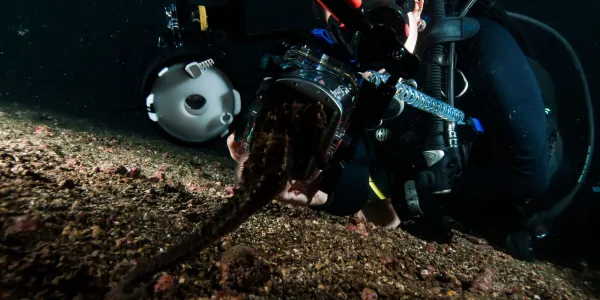Is it a frog? Is it a fish? No, it's a frogfish! These sought after critters don't particularly look like frogs, but they certainly look rather strange. Frogfish come in a mind-blowing variety of sizes, shapes, colours, and even textures, and account for some of the rarest species in the underwater world. Plus, most divers agree – they're so ugly that they're cute!
Whether you're a frogfish fanatic that wants to learn more about these fascinating animals, or a newly minted macro enthusiast hoping to find your very first one, this is your article! Stick around for tonnes of interesting information on these elusive animals, including how they evolved, where in the world to look for them, and how to spot one – despite their incredible camouflage.
Keep reading for all the facts about frogfish.
Frogfish basics
Part of the anglerfish family, frogfish are short and stocky, oddly shaped, and sometimes covered in spines, hairs, or other appendages to help them blend in with their surroundings. They also have a lure-like appendage that sprouts out of their foreheads, that they bob and sway in the current – hence the name "angler". This action helps to bring unsuspecting fish in range of the frogfish’s strike, an ideal strategy for this sedentary ambush predator.
Despite its strange and scaleless appearance, the frogfish isn't a reptile or an amphibian – it is a fish, with gills like any other. Unfortunately, few fossil records of frogfish exist – and their closest genetic relatives, handfish, are equally rare – meaning surprisingly little is known about the origin of these unique underwater animals.
Today, there are around 50 known species of frogfish. The smallest species, the dwarf frogfish ranges in size from 1.5 to 5 centimetres, while the largest, the Commerson's or giant frogfish, can grow up to an astonishing 38 centimetres. Between the two are an astounding array of sizes, shapes, and colours, with freckled, hairy, and even ‘psychedelic’ skin.
What makes them special
So, why do scuba divers love frogfish? First of all, they're hard to find. Even though these cryptic critters live in tropical and temperate waters worldwide, their exceptional camouflage makes them a real challenge to spot while scuba diving. Many species can change colour, and others use algae and hydroids to enhance their disguise. They are also slow-moving, preferring to stay perfectly still and blend in with the surroundings.
Frogfish also display a few behaviours that divers and underwater photographers hope to witness. While on the hunt, a hungry frogfish will extend, then wave its lure to attract the attention of a potential meal. Different species have their own unique ‘bait’, with some lures looking like worms and others like fish or shrimp. Once the prey is close enough, the frogfish strikes, swallowing its victim whole in a matter of milliseconds.
Frogfish can also be seen yawning, stretching, and slowly walking, which all add up to a more comical appearance. And when they're trying to move a bit faster, they kick into high gear using jet propulsion, pumping water out through its gill or opercular openings found behind its pectoral fins.
Finding a frogfish
Frogfish can be found in oceans nearly worldwide, with a few notable exceptions like the Mediterranean Sea. But, simply knowing frogfish live in a particular muck diving destination isn't enough to help you find them. Instead, if you want to spot one, you'll have to think like a frogfish!
Like many macro species, these strange bottom dwellers prefer to live on the ocean floor where they can blend into the silt, muck, or rubble bottom composition. You’ll also often find these ambush hunters positioned right on the edge of corals and sponges, allowing them to snatch a meal right out of the blue as it swims past. Vertical environments like piers and pylons are also great spots to look for frogfish. These artificial reefs offer shelter from the current and often attract juvenile reef fish and other easy targets for prey.
Because frogfish are often found in silt and muck environments, they frequently sport multicoloured or mottled skin. And, they might even take on strange textures to try and mimic the soft coral or other formations surrounding them.
Even if you're in an area famous for critters, like Lembeh or Ambon, finding a frogfish can present a challenge. To make it easier, take tips from other divers. Frogfish move slowly and typically have a very small home territory – so if one has been seen on a dive site recently, it probably hasn't wandered too far. You may also have better luck locating frogfish during night dives when they might be more active and responsive to an underwater light source, like your torch.
Discover Lembeh Strait
Search from the top eco-friendly dive resorts in Lembeh
Frogfish photography
Whether you think they're cute or creepy, frogfish are one of the ocean's most photo-worthy subjects and a top pick among macro fanatics. And, thanks to their slow-moving lifestyle and patient behaviour, they make for easy introductory subjects. In fact, so long as you don't disturb them, they're even likely to show off for the camera, yawning or waving their lure.
Just keep in mind that your camera's flash is extremely bright for an animal this size, so repeated photography could stun or even blind your newfound friend. And, be sure to maintain perfect neutral buoyancy while shooting to avoid disturbing your subject or stirring up sediment in the water around you – this is absolutely essential in silty environments! For more tips on getting the perfect shot, check out our full macro photography guide.






